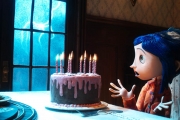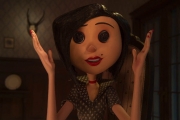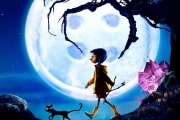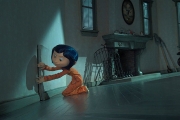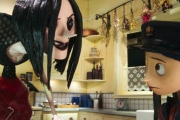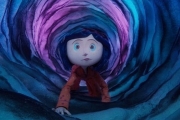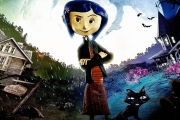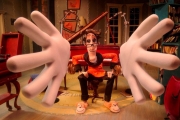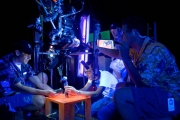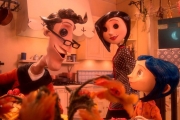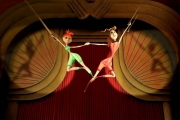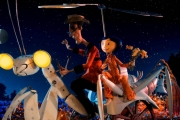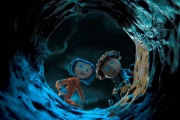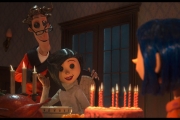![]() Presentation by and discussion with director, screenwriter and producer Henry Selick and composer Bruno Coulais
Presentation by and discussion with director, screenwriter and producer Henry Selick and composer Bruno Coulais
Coraline Jones is an intrepid little girl with unlimited curiosity. Her parents, who just moved with her into a strange house, do not have much time for her. In order to fight off boredom, Coraline decides to explore every corner of the house. Opening a condemned door, she enters into an apartment that is identical to hers . . . but where everything is actually different. Coraline is tempted to move into this wonderful World which meets all her expectations. Yet, the dream will soon become a nightmare. . .
• Annie Award for best character design and production design, 2010 •
• Annie Award to Bruno Coulais for best music for cinema, 2010 •
• Oscar, Academy Award and Golden Globe nominations for Best Animated Feature •
Cast & Crew
Director / Screenwriter • Henry Selick
Director of Photography • Peter Kizachik
Based on Neil Gaiman’s novel Coraline
Music composer • Bruno Coulais
Producers • Henry Selick, Claire Jennings, Bill Mechanic and Mary Sandell
Starring :
Dakota Fanning, Teri Hatcher, John Hodgman, Jennifer Saunders, Dawn French and Ian McShane
Choose a picture to see the filmography (source : IMDB)
![]()
What were some of the challenges of scoring Coraline? What were you trying to accomplish with your score in terms of its relation to the story and characters?
For me [when scoring a film], the story is not very important – it is not so interesting to say with the music the same thing as the story. So, I think in Coraline the music is sometimes “behind the wall,” like ghosts that haunt the movie. It was very interesting to have the music evolve. In it beginning it sounds very quiet and realistic because it is a realistic world. And little by little the music becomes quite scary by the end of the movie.
How did you accomplish that escalation? Through orchestration? Volume? A change in the melodic material?
For me it is very important to make my own orchestrations. Depending on the density of sequence, sometimes I will have just a few instruments — strange instruments like the water phone. It is a metallic percussion where you put water on a kind of basin with a tube and a bowl. You can play notes on it, and it is a strange, beautiful, very deep sound. At the very beginning I wanted the music to be quiet but with strange sounds. I used a string quartet, a lot of percussion, and there is a very special sequence — the marching band of the mice circus — where I tried to be at the scale of the mice, so I used toys and Chinese instruments along with traditional marching band instruments.
How did you wind up doing the score for Coraline, and what was the process like?
Henry Selick tried [putting] a lot of [temp] music with his drawings, his animatics, and I do not know why, but he tried the music I made for a movie called Microcosmos, and it worked! Then I met Henry in L.A., he sent me the animatics, and I started to create some themes and melodies. Then, little by little, I began to see construction of the film. It was good because I had the time to change my mind, to change the orchestrations. It is great to work on an animated movie because you have that time — the process is very long.
Did your ideas about the score change a lot during the years it took to make Coraline?
Not too much, but for me there is an important correspondence between the lighting and the tonalities of the orchestration. I need to see the real images [before I can finish the music]. But I do not think I changed my mind too much. I would send Henry my demos, and immediately I would have an answer from him. We were very far away in terms of distance, but very close [creatively].
Where did you record the music?
We recorded in Paris, the children’s choir in Nice, the orchestra in Budapest and then we mixed the film at Skywalker Sound, California.
Not every film composer does that writes his own orchestrations. Is this something you have always done?
Oh yes. It is important for me to write my own orchestrations because when I think of melody, I think of it with the instruments I will write with. I love to write orchestrations. In Coraline I have a big orchestra, especially the string [section]. I tried to do something very special with the strings so there are a lot of glissandi and microtonalities. I expect the audience to feel that the ground is not so stable. And with the children’s choir there are a lot of contrapuntal voices. I think when you are very young, it is the age of terror, of fear, so I think in movies when you use something very close to a childhood you create a fear, and a fantasy. For example, music boxes, sometimes when used in the music for movies they are very strange and scary.
Where do you get your inspiration as a composer?
It depends. When I start to write music, I do not have any ideas. I am all forgetting. It is important for me not to stay in my office and try and write music. Exhibitions are very important to me, along with the light and reading. Then the inspiration will come. And when I find the way, I am able to work a lot, all the day and night. Because I am very lazy, when I have an idea I am very happy to keep it!
What do you read?
It depends. I am crazy about literature. My favorite writer is Proust. But also James Joyce.
The modernists.
Yes.
Does the writing of those authors inform your ideas of compositional structure?
Yes. It is strange, because when I read a book and I am passionate about it, suddenly I have some [musical] ideas. And, again, the lighting [of scenes] is very important – lighting, colors, everything under the story. For me, there are some colors I cannot write tonalities for, and some lighting I find impossible to put in music. When a sequence is too realistic, it is very difficult, which is why it was great to work on Coraline and its fantasy world.
What composers have inspired you?
All the classic composers. Stravinsky. Prokofiev. Ligeti. And for the movies, I have a lot of admiration for Bernard Hermann and Nino Rota. Hermann especially – his use of music is very interesting because it does not correspond exactly with the sequence. Sometimes he was able to create fear with very emotional music.
What was it that struck you most about working with Henry Selick?
It was so amazing to see how Henry worked. I went to the studios in Portland, and it was incredible. Three hundred people working all the time, and Henry was able to [stay on top of] all this work. It is the same as when you are writing an orchestration — you have to keep in your head all the sounds. Henry, he had his whole movie in his head. It was incredible.



